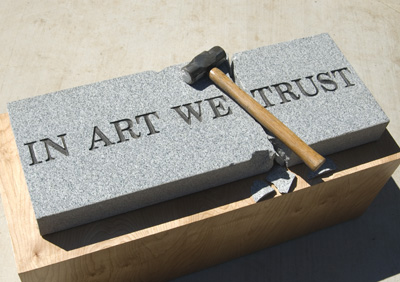|
Art Picks
Where the idea comes first
Irony and language contribute to Ronald C. Peetz's works of conception work
By Victoria Dalkey, Sacramento Bee Art Correspondent
 |
"In Art We Trust" Ron Peetz/2010
|
| |
|
"Modus Operandi: Idea Based Work" is the title of a show by Ronald C. Peetz at b. sakata garo. In idea-based work or
conceptual art, the artist puts the cart before the horse, settling on an intellectual concept first and then executing
the work. It is the opposite of the process in which an artist begins by searching for a form, working through layers of
experimentation, before arriving at a final object.
Bruce Nauman, who is perhaps the most famous conceptual artist in the country, hit on the idea of such works early in the 1960s while a student at the University of California, Davis. Among his early conceptual works here was a series of flower paintings, which took the form of piles of flour scattered on a gallery floor. Setting the tone for what would follow, the work relied on wordplay, a bad pun, and a "dumb" action.
Peetz followed in Nauman's footsteps back in the 1960s, gaining some acclaim for his contribution to the legendary Slant Step Show, an exhibition centered on an enigmatic object discovered by William T. Wiley, who taught at UC Davis at the time.
The Slant Step, a mysterious object that had no discernible use, became the focus of a kind of cult worship among the Funk artists of the day, Peetz included.
There is a nod to the Slant Step in "Modus Operandi" in the form of a saw blade that takes the shape of the step on which is written: "It is probably best that you do not understand or even know what this is." Thus the mystery is perpetuated.
More typical of his recent work is a series of granite tombstones inscribed with texts, such as "The Tomb of the Unknown Soldier," which bears the words "don't ask; don't tell." The ironic political commentary is pointed. Less apparent is the meaning of "In Art We Trust," a tombstone broken by a sledgehammer that may or may not be a comment on the state of contemporary art and our trust in it.
Another series of new works takes the form of X-ray pictures of a crucifix. In "Test of Faith," the figure of Christ becomes literally a ghost, calling into question the holiness of the object and the emptiness of the symbol. It's a trenchant piece of criticism, with enough ambiguity to make the work intriguingly mysterious.
Similarly engaging is an X-ray of a Howdy Doody puppet puckishly titled "Explaining Ventriloquism to Mikey." Other pieces that rely on wordplay include "Shadow," a piece in which the word "Doubt" is etched into glass so that it casts literally "a shadow of a doubt" on a painted backdrop. Its irony is echoed in "Manifest Destiny," a piece in which a large painting of the sea bears the wavering, faint word "Progress" while the painting is secured to the floor by an antique anchor that metaphorically drags down the manifest destiny that we once saw as progress but now experience as an empty concept.
At times Peetz abandons wordplay to give us strong works in the realm of pure Dada sculpture. "Lost at Sea" is a haunting piece made of wood, paint and a canoe paddle. The paddle rises from a wooden sea of blue paint along with a bottle cast upon the splintery waves. It's a handsome and perplexing piece, as is the brilliant chalk drawing "Sailor Take Warning," with its image of Popeye spying some dark cataclysm on the horizon.
I also liked the dark metaphor of "Loss," a heart pierced and pressed by a giant C-clamp, and "Hostage," a steely version of Munch's "The Scream" with eyes and mouth made of combination lock tumblers. Peetz makes reference to other artists in "Prayer for Rauschenberg," a jointed artist's model doll sacrificed on a cross, and "Eminent Domain," a house of cards threatened with a sledgehammer that is dedicated to H.C. Westermann, the legendary artist who had such a strong influence on sculptors in the 1960s and '70s.
Peetz walks a thin line in these works. They could fall flat or come off as shadowy concepts, but he does them so well and so thoroughly with a fine sense of craft that, like Steve Kaltenbach's idea-based pieces, they pack a punch and linger in the mind.
It's nice to see someone keeping the Dada spirit alive.
The show continues at b. sakata garo, 923 20th Street, (916) 447.4276 through Saturday, October 2, www.bsakatagaro.com
|